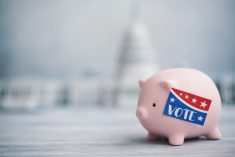Here’s my definition of herky-jerky: an overreaction of equal magnitude but opposite direction to previous overreaction. Disclosure: I am in no way an expert on the nuances of money supply and the inner workings of bank policy. What follows is my layman’s perspective of what caused the March bank panic.
To say I am puzzled by the last few years of fiscal (government spending) and monetary (central bank) policy would be an understatement.
Governments around the world caused an unprecedented recession by effectively ordering people to stay home for significant periods of time. I will not venture into whether these lockdowns were justified or not, just that they clearly caused a recession. Central banks then rapidly cut already low interest rates to bring economies out of the recession. Am I the only one who sees a disconnect between these two things? Wouldn’t the cure for the recession be the opposite of what caused it?
Read Also

Gentle treatments for pain in the neck
Heading toward year-end, people unknowingly tense up against the cold and busyness, causing neck pain that can often be treated with appropriate support and gentle mobility, athletic therapist Kathlyn Hossack says.
That’s how the normal economic cycle works. Economies get hot, leading to greater demand for money causing the cost of that money to go up via interest rates. This greater cost of money reduces demand for it, leading to a cooling economy, which brings interest rates back down.
Besides taking interest rates to unprecedented levels, governments printed money ad nauseum, sending checks to virtually anyone who wanted them. Authorities didn’t think this money supply expansion would cause inflation because it didn’t cause inflation during the 2008-09 financial crisis.
However, 15 years ago the main purpose of the money was to shore up bank balance sheets and it filtered into the economy slowly. The U.S. government, in time, got its money back and profited from the effort to stabilize the banks. This go-round, money went directly into people’s hands and people did what they do best … spent it, during a time when supply chains were significantly constrained. Voilà, inflation. I predicted this inflation, as did many others except the financial authorities, well before it occurred.
Governments and central banks didn’t believe the inflation spike would last, calling it transitory, and vowed to keep rates lower for longer, fuelling speculative excess. Bond prices and, thus, interest rates are generally set by the market, just like other commodities. The central bank or overnight rate is what banks charge each other overnight to settle small overages and underages in their accounts. It’s also what central banks charge for overnight loans to public banks. The rate is significant in that it sets the tone for other rates, especially the prime lending rate.
The following comments are U.S. focused but played out similarly in Canada. Normally, the one-year treasury rate and the federal funds overnight rate track each other closely. However, in October of 2021, as reopening gained steam, the market-based, one-year bonds started to pull away from the fed funds. By the time the U.S. Federal Reserve made its first move in March of 2022, the one-year rate was already 1.6 per cent. What ensued was one of the most dramatic interest rate policy escalations in history. The overreaction to the previous overreaction so to speak.
As interest rates go up, the value of bonds goes down. The longer the term to maturity, the more they drop. Who wants a 30-year bond yielding 1.2 per cent when you can now get them yielding 3.5 per cent? The price of the 1.2 per cent bond must drop so that they both bring the same value at the end of the 30-year term.
Silicon Valley Bank (SIVB) was established in 1983 as a bank for the emerging technology and biotechnology industries. It had been very successful and by all accounts its underlying business remained sound. However, it parked a lot of cash in long bonds. When it announced the sale of those bonds booking a $1.8-billion loss, depositors got nervous and started withdrawing deposits en masse.
Banks borrow short term (deposits) and lend long term. You don’t have to stand in line anymore to move your money, and when depositors started clicking, the Federal Deposit Insurance Corporation had to step in quickly. This became the second largest bank failure in U.S history. Shortly afterwards, cryptocurrency-oriented Signature Bank also failed. Then a significant European bank, Credit Suisse (CS), was forced into a merger with fellow Swiss-based UBS, although CS had been in decline for a long time.
Canada’s banking system is more concentrated and regulated than the U.S. system. There have been more than 500 bank failures in the United States over the past 15 years, the bulk of which occurred between 2008 and 2011, however, a few occur almost every year. We have only experienced three small institutional failures over the past 40 years and none since 1996.
As Charlie Munger famously quipped, “You don’t have to be that smart … you just have to be consistently not stupid.”
SIVB made a stupid decision to load up on long-duration bonds when interest rates were almost zero. My hope is that by the time you read this the panic has subsided. I personally don’t think we are in as serious a situation as occurred in 2008, but only in time will we know.
More on interest rates
I used the following three figures in a recent keynote address. The title for this address was “Parallels Between Successful Farming and Successful Investing.”
Figure 1 shows nominal (before inflation) and real (after inflation) U.S. stock, bond and cash returns. What I found very interesting, in real terms, bonds lost money between 1940 and 1980, and they didn’t make any money between 1900 and 1980. All the gains in bonds have come over the past 40 years as interest rates declined from 20 per cent to zero.

You can also see the small hook at the top of Figure 1 (above) illustrating the 2022 bond value losses. Is this the beginning of another long period of bond underperformance as interest rates increase? You know my stance on predictions, but I think there is a distinct possibility.
Figure 2 (below) shows how market-based interest rates were moving higher well before the U.S. Fed rate. It also demonstrates the dramatic drop in market rates with the collapse of SIVB. The Fed, however, continued to be out of sync with the markets and raised rates. In another highly unusual situation, overnight lending rates are now the highest of all rates, whereas it is normally the lowest of all rates.

Figure 3 (below) shows that while current rates are higher than the past decade, they remain low from a long-term, historical perspective. I believe that interest rates in the five to 10 per cent range are better for the functioning of society, as all resources that are too cheap get wasted, including money. The examples of wasted money abound: non-fungible tokens, cryptocurrencies, speculative stock collapse, overheated housing and speculative bonds. (What else can you call 30-year bonds at a one per cent rate?) While the zero interest policy was not the only cause of wasted money, and speculative excess can occur in a higher-rate environment (see 1998-2000 rates), I believe they contributed significantly to the current situation.

That said, and while I think interest rates should and will go higher in time, the herky-jerky movement isn’t the way to get there. A steady-hand approach would be more beneficial, as it is in all pursuits.
















